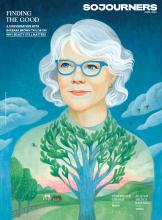IN THESE UNCERTAIN times, I look for witnesses who will guide me to a more hopeful future. I do so because I cannot overcome my anxieties alone. I recognize the affective, spiritual, and communal dimensions of healing and recovery. When we heal and witness together, we are emboldened to witness the life-giving hope of the divine with the other more than ever.
In this month’s reflections, I see various sources of hope and witnessing. Beyond anthropocentrism, I see that nonhumans, particularly jackals and ostriches, are guiding us in our relationality with the divine and others (Isaiah 43:16-21). In responding to trauma, I seek the wisdom of women (“daughters of Jerusalem”) who have been down this road before (Luke 23:27-31). With their guidance, I hope for a peaceable kingdom that is unmitigated by false hopes and spiritual bypassing.
My last reflection engages Thomas the Twin (John 20:19-31) and the inauguration of Donald Trump for a second time. Here, I offer a weary posture of the discombobulated mind that is still trying to grasp the impact of his inauguration. I am trying to breathe amid a sense of despair. So, I hope that you will breathe as well, say a prayer or two, talk with a trusted friend, be with your animal companion, and relish your personal solitude. In all ways, I hope that you will find hope as you witness and become witnesses of social holiness.
Read the Full Article

